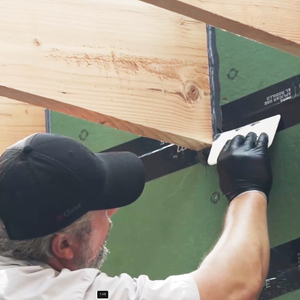An inductive voltage probe says that several circuits in my circa 1967 house have “hot” grounds. That is the probe responds when I touch the metal cover plate on the outlets and switches on this circuit (grounded metal boxes). However, when I use a multimeter to check voltage and circuit continuity for the circuits in question to known good circuits via an extension cord, everything looks fine. Continuity for the ground and neutrals are as expected, 120 Volts from the hot to ground/neutral, no potential between the ground on the “hot” ground and the known good ground. Similarly, I checked with a plug in 3 light circuit tester which indicated the circuit was wired correctly. The issue goes away if the circuit is turned off at the breaker.
I don’t understand how the inductive probe works so I am not sure what to deduce from this. I am assuming that if I had a short from a hot circuit to ground that I would trip the breaker or at least be able to see some potential on the “hot” ground.
Does anyone know how these probes work and what might be causing this response. Should I be worried? and if so about what?
Thanks!


















Replies
If you're talking about "tick" testers,some of them are too sensitive for your own good.I have two and sometimes in a full junction box I can get different readings from them,and even moving one around on a particular conductor,they can read differently.False positives are more common than false negatives.
If you've tested correctly with a multimeter or "Wiggy",and your described method seeems sound,than I'd say your probe is just picking up the hot conductor through the receptacle, and you're OK.I'd probably string a piece of wire along the floor from the panel,connected to the ground bar,all the way to the receptacle in question,and if the multimeter on the voltage scale reads 0 volts between the cover plate and "absolute"ground, than just dismiss the probe as meter b.s.
"dismiss the probe as meter b.s."
AMEN! Heard the space station disconnected all the GFCI type stuff 'cause the lawyers got ahold of a couple of 'anginers' "parts" and got some stupid stuff 'designed' in.
I am with you Barry. I traded my probe for a sheet metal circle cutter. I figured if it was giving me false positives, I was better oof with my VOM, since i was oing to have to use it anyway. By the way if it is a Greenlee, it is going to go bad sooner than later.
Dave
Tools have strengths and weaknesses. Probes are good for many tasks that cannot be easily done other ways. They are great at differentiating between hots and neutrals on K&T wiring where insulation color codes are unreadable or mixed. As a quick second check of other means they are good.
The Wiggy shows it's dead but it's a tight attic, you won't be able to pull back, and you are forced to work the box while stretched across an AC duct, your well grounded. Your soaking wet with sweat so if you get bit it is going to hurt. The Wiggy got bashed a few times in the crawl over. A second opinion might be a good idea and the ability to sense a live wire without a ground reference, needed with meters, can save you trouble.
The earth is grounded. If you kneel and there is any appreciable moisture present you are grounded. If the neutral and ground on a circuit are damaged or disconnected a meter will read the circuit as dead. Even checking hot to dirt many times a meter will read next to nothing. A Wiggy will read only if the voltage to ground are higher than 120v or the dirt is very wet. This is also true on a concrete slab.
Wiggy says it's dead. Meters, especially high impedance digital ones, are sometimes prone to reading transitory potentials that are not uncommon to unimportant induced voltages. It would be easy to think the circuit is off. Touch the live and you get a reality check on the limitations of equipment. Tracers, Tic checkers, provide a valuable second or third opinion. Given that they are light, relatively cheap and quite easy to carry in a shirt pocket they have earned a place in my tool kit.
They have limitations. They won't read through metal. Even the spread stranded ground of a range cable will often block the signal. I once blew a #8 strip hole in a pair of Kleins learning this lesson. You didn't really expect me to read the directions did you? They are sensitive. More prone to "false" positives. Batteries go dead. Tweeters can sometimes be missed on noisy job sites. Being small and linear they are easy to forget about, subject to abuse and can be brak if you sit on them. But then again meters use batteries that also go dead. Wiggy leads get a lot of abuse and can, I keep a spare set of leads on the truck for just such an occasion, fail at the least oportune times.
Even some of the "failures" can often tell you something. Many times I have had "false" positives tell me about bad connections in between the test point and the panel. As soon as I tighten the lug in the panel or redo the loose or corroded connection the probe no longer reads. Was it a "false" positive or was it giving useful information. Like anything else. It depends. How marginal does a connection have to be to read, justify correction, represent a hazard.
Like any other tool probes have jobs they do well and others they stink at. Getting used to your particular model and understanding what it is reading goes a long way toward trusting it. I have found the more expensive adjustable models to be more adaptable but the $10 ones have a place.
They work sort of like a radio signal strength detector. Voltage and frequency are what they depend on. They're much more sensitive at higher frequencies, and may stay constantly on near a broadcast transmitter. The first ones I saw were from the Texas Association of Broadcasters, about ten years ago.
They won't read through grounded conduit, but they may read floating conduit as hot. With a high impedance meter, floating conduit or floating conductors may read some wierd number like 30 - 80 volts. Put a 15 watt incandescent light in parallel with the meter to make it low impedance, and that reading will go to zero to both hot and neutral. Capacitance between the floating item and hot and neutral forms a sort of voltage divider.
I like the proximity tester for making absolutely sure that I've found every fuse or breaker that feeds anything in a box before I do much work on it. They'll also blink briefly for a static discharge, so you can test them by rubbing them on your sleve (just one stroke), then touching them to your arm. I always do the blink test before I rely on a negative reading.
-- J.S.
Made my point with a previous post but I just got off a job that was right up the little probes alley. A breaker wouldn't set. The HO, it was an out building, said it hadn't held for years but now the intended use had changed and they wanted the lights in a back room to work.
The breaker blew immediately when reset. What an electrician calls a bolted short. A signal that there is massive damage. Receptacles behind the headboard of a well used bed sometimes gets mangled enough to cause this sort of short. I check the panel just to cover the base.
Lights and a few receptacles are on the circuit. The switch was tilted so I check the box. Nada. Look around using the probe to find the receptacles that are dead. Form a mental picture of how the circuit is run. Check a receptacle that looks like it may have flashed. Nothing.
I start where I think the middle of the circuit is and lift the hot to segregate part of it. Breaker still won't hold. I try what I think is the first box on the circuit. Breaker blows when reset. Its the home run. A look for nails or screws that may have hit the cable on the wall above the panel yield nothing. Attic time.
I get into the attic close to the last box. Problem this building has more circuits that many houses. Lots of romex. Looks like a snake race. Probe finds the dead cable and helps me track it back through a tangled mess. I work toward the panel and sure enough I find the problem. A screw missed the truss and hit the cable dead center shorting the hot to the ground.
I install two boxes to replace the piece I cut out. Job done I move on. Would have taken much longer without the probe. Anything that saves me time in a hot attic gets to stay in my tool pouch.
4Lorn1,
You may have stated this already, but do you have a favorite brand of inductance probe that may work better than others? I share your opinion that they're useful to have around, but also share the frustrations of others with so many false positives!
Ragnar
I have three. Two pencil type: A little red Gardner Bender model that was just $10 but is handy and about as accurate as the other pencil type but the method of turning it off, the pocket clip is pressed in to meet a contact on the main body, is weak so it can, without some care, drain the batteries. I try to make sure it is firmly clipped to the tool pouch. The batteries are button type that drain quickly and are fairly expensive. I can, with some care, get six months of reliable service from a set.
The second pencil type is a yellow Greenlee model that is a bit more stout in construction and the color may help me find it when I drop it in an attic. I haven't had it as long but it seems about, maybe just a bit more accurate, as the GB probe. It uses two AAA batteries that provide a longer life and a cheaper bill when replacements are needed. The on/off switch is the pocket clip again but you slide it. It is arranged, by design or luck, so that when I reclip it to a pocket it tends to turn off.
The third model is also a Greenlee but it is a larger model. About $18 if I remember correctly. It uses two AA batteries that I have never had to replace. The on/off is by way of a dial on the side. This dial also controls sensitivity. On high I can often read live wires in a wall. Adjusted lower I get far fewer false readings and can much easier read closely spaced wires. Zip cords and lamp shells are fairly hard to read with the pencil types but easy with the adjustable one. Interesting how many lamps are miswired. This unit is about 5" long and about 3/4 by 2 in cross section. It will fit in a shirt pocket but it is not as handy. It tends to stay on the truck.
90% of the time I end up using the pencil type. Not because they are superior instruments but because they are clipped to my breast pocket or tool pouch they are more likely to be at hand when I need them.
With some practice and experience any of these units can give you valuable information. Care must be taken to keep in mind the strengths and limitations inherent in these devices. When you get into situations where you are dealing with higher voltages or where you will be grounded or unable to pull back, a tight and wet crawl space comes to mind, a second or even a third check with other instruments may be called for just to make sure. It only takes one electrocution to ruin your whole day. So be safe.
Would also like to point out that sometimes I have received false NEGATIVES from these testers. I cannot isolate exactly when this happens but I would definitely not bet my life on a wire being dead if one of these testers says it is dead.
Nor would I trust my life to one. Same goes for any device. Induction probes will not read through shielding. The wire mesh in some plaster jobs, conduit or even the stranded ground of a range cable wound around the hot conductors can interfere with the probes ability to sense voltage. All test devices have limitations.
A sound knowledge of these particular limitations and an estimation of the risks involved will need to guide you in maintaining safety. The greater the risk the more you will need to have multiple perspectives, safeguards and backups to maintain the same degree of relative safety.
On the other hand you don't need the protective clothing of an industrial, high voltage, switch puller to change batteries in a flashlight unless the flashlight is enormously powerful or you are extraordinarily accident prone. I contend that some should only participate in construction activities with Nerf tools while wearing a straight jacket. Preferably in a rubber room with direct adult and psychopharmacological supervision.
4Lorn1,
Thanks for the opinion on the inductance probes. I, too, have a little red GB. I think I'll get that more expensive one you mentioned last so that I have a "second opinion" meter. ;) Also, the variable sensitivity sounds like a good idea.
Thanks again.
Ragnar